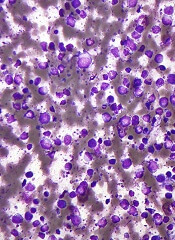
Interim results of a phase 1/2 trial suggest KTE-C19, a chimeric antigen receptor (CAR) T-cell therapy, can be effective against aggressive non-Hodgkin lymphoma (NHL).
KTE-C19, administered after conditioning chemotherapy, produced an overall response rate (ORR) of
79% and a complete response (CR) rate of 52%.
However, the therapy also caused severe adverse events (AEs), and there were 2 deaths resulting from KTE-C19-related AEs.
Kite Pharma, Inc., the company developing KTE-C19, released these results and said additional data from this trial, known as ZUMA-1, will be submitted for presentation at an upcoming scientific meeting.
ZUMA-1 has enrolled patients with chemo-refractory, aggressive NHL. The phase 1 portion of the trial included 7 patients with diffuse large B-cell lymphoma (DLBCL).
Thus far, the phase 2 portion includes 62 NHL patients—51 with DLBCL and 11 with transformed follicular lymphoma (TFL) or primary mediastinal B-cell lymphoma (PMBCL).
The patients received a conditioning chemotherapy regimen of fludarabine and cyclophosphamide, followed by a single infusion of KTE-C19 (at a target dose of 2 x 106 CAR T cells/kg).
Responses
In the phase 1 portion of the trial (n=7), the initial ORR was 71%, and the CR rate was 57%. At 3 months of follow-up, the ORR and CR rate were both 43%. The response rates remained the same at 6 months and 9 months of follow-up.
In the phase 2 portion of the trial, for all 62 patients, the initial ORR was 79%, and the CR rate was 52%. At 3 months, the ORR was 44%, and the CR rate was 39%.
Among the 51 patients with DLBCL, the initial ORR was 76%, and the CR rate was 47%. At 3 months, the ORR was 39%, and the CR rate was 33%.
Among the 11 patients with TFL or PMBCL, the initial ORR was 91%, and the CR rate was 73%. At 3 months, the ORR and CR rates were 64%.
Longer follow-up data are not yet available for the phase 2 portion of the study.
Safety
For all 62 patients, the most common grade 3 or higher AEs were neutropenia (66%), anemia (40%), febrile neutropenia (29%), thrombocytopenia (29%), and encephalopathy (26%).
Grade 3 or higher cytokine release syndrome occurred in 18% of patients, and neurological toxicity occurred in 34%.
Two patients died from KTE-C19-related AEs—hemophagocytic lymphohistiocytosis and cardiac arrest in the setting of cytokine release syndrome.
Kite Pharma said the primary analysis from this study will include 101 patients with chemo-refractory NHL (DLBCL, TFL, and PMBCL), will have approximately 6 months of follow-up, and is expected in the first quarter of 2017.
ZUMA-1 is supported, in part, by funding from The Leukemia & Lymphoma Society Therapy Acceleration Program.


